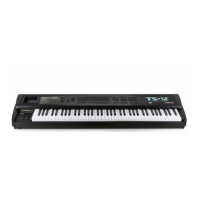TS-12 Musician’s Manual Section 2 — System Page Parameters
11
• HARMONIC-C — This is a mathematically generated scale based on the relationships of the
partials in the harmonics of the fifth octave of the linear harmonic spectrum. It is interesting
mostly from a theoretical standpoint.
• CARLOSALPHA — The first of three scales derived mathematically by Wendy Carlos in the
search for scales with the maximum purity of primary intervals, Alpha is based on the
division of the octave into 15.385 equal steps (78 cents per key). One pitch “octave” covers 16
keys, though because the Carlos scales are asymmetric (not based on whole number divisions
of the octave) they do not yield pure octaves.
• CARLOS-BETA — Wendy Carlos’ Beta scale is based on the division of the octave into 18.809
equal steps 63.8 cents per key). One pitch “octave” covers 19 keys, though, again, being
asymmetric it yields no pure octaves.
• CARLOSGAMMA — Wendy Carlos’ Gamma scale is based on the division of the octave into
34.188 equal steps (35.1 cents per key). This scale has essentially perfect major thirds, fourths
and fifths. One pitch “octave” covers 35 keys, though, again, being asymmetric it yields no
pure octaves.
• PARTCH-43 — Harry Partch was a pioneer of micro tonality in the early 20th century. He
developed this 43-tone-per-octave scale of pure intervals, and even designed an entire
orchestra of instruments for music using this scale. The tonal center is found on key D2 (the
low D on the 61-note keyboard). This pitch-table has been transposed up an octave to bring
the notes into a more usable range.
• REVERSE — This pitch-table simple reverses the pitch-tracking of the keyboard, putting the
highest notes at the bottom of the keyboard and the highest notes at the top. Lots of fun.
Selecting ROM Pitch-Tables
Here’s how to select and use the Internal ROM pitch-tables:
1) Start by selecting a sound from the internal memory of the TS-12. We recommend using a
piano, organ, or guitar sound. Do not select a drum kit or percussion sound, as these sounds
use the TS-12 Drum-Map and will not respond to pitch-tables.
2) Once you have found a sound you like, press the System button four times. The display will
read SYSTEM PITCH-TABLE=
NORMAL
. The NORMAL pitch-table is the default pitch-
table of the TS-12 and is known as the western twelve tone equal-tempered tuning. Play a
scale on the keyboard and listen to the pitch of each note.
3) Press the Up Arrow button three times to display the first ROM pitch-table (PYTHAGRN-C)
and play the keyboard. Notice that the TS-12 is now using an alternate tuning. The first
several ROM pitch-tables will make subtle changes in tuning, while the remainder of the ROM
pitch-tables will have a more obvious affect.
4) Press the Up Arrow button again and play the keyboard. Continue scrolling through the
remaining pitch-tables and listen to the tuning variations offered.
If you would like to continue using a particular pitch-table with other sounds, press the Sounds
button to return to the TS-12’s internal sound banks. The currently selected System pitch-table
will remain in affect even after turning the TS-12 power off and back on. In this way, if your
music requires the same pitch-table all the time, you can simply turn on the TS-12 and start
playing.

